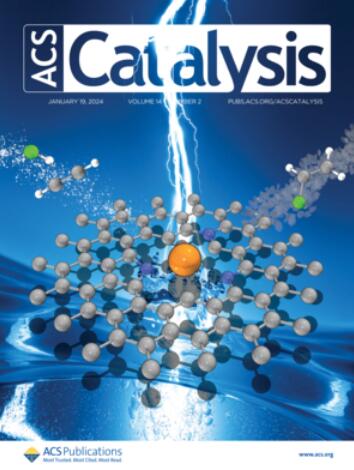Ultrahigh-Throughput Activity Engineering of Promiscuous Amidases through a Fluorescence-Activated Cell Sorting Assay
IF 11.3
1区 化学
Q1 CHEMISTRY, PHYSICAL
引用次数: 0
Abstract
Ultrahigh-throughput methods such as flow cytometry are ideal tools for the directed evolution of enzymes by enabling the screening of up to 109 variants per day. In this study, we developed an assay based on fluorescence-activated cell sorting (FACS) for the detection and engineering of amidase activity in whole cells. The assay establishes a stable genotype–phenotype linkage by coupling coumarin-based hydrolysis products to intracellular glutathione via a recombinantly coexpressed glutathione S-transferase. To demonstrate the applicability of the FACS-based assay, we engineered an amidase from Sphingomonas alpina (SaAmd) by screening combinatorial libraries with multiple amino acid positions randomized simultaneously. SaAmd variants containing proximal double mutations exhibited not only almost 5-fold improved activity against structurally different amide substrates but also coevolved promiscuous carbamate- and ester-hydrolyzing activities, which exceeded the wildtype activity up to 6-fold. Importantly, triple variants featuring distal mutations in three highly flexible loop regions, displayed up to 16-fold enhanced specific activities toward small molecules containing highly stable N-aryl amide and carbamate bonds. These motifs are commonly used as protecting groups for amines in organic synthesis but can also be found in environmental contaminants like pesticides and plastic waste. Therefore, the developed FACS-assisted assay has great potential to accelerate the engineering of amidases for versatile biotechnological applications.

荧光活化细胞分选法研究混杂酰胺酶的超高通量活性工程
流式细胞术等超高通量方法是酶定向进化的理想工具,每天可筛选多达109个变体。在这项研究中,我们开发了一种基于荧光活化细胞分选(FACS)的检测和工程全细胞中酰胺酶活性的方法。该实验通过重组共表达的谷胱甘肽s转移酶将香豆素水解产物与细胞内谷胱甘肽偶联,建立了稳定的基因型-表型连锁。为了证明基于facs的检测方法的适用性,我们通过同时随机筛选多个氨基酸位置的组合文库,从鞘单胞菌(SaAmd)中设计了一种酰胺酶。含有近端双突变的SaAmd变体不仅对不同结构的酰胺底物的活性提高了近5倍,而且还共同进化出了氨基甲酸酯和酯的混溶活性,比野生型的活性提高了6倍。重要的是,在三个高度灵活的环区中具有远端突变的三重变异,对含有高度稳定的n -芳基酰胺和氨基甲酸酯键的小分子显示出高达16倍的增强特异性活性。这些基序通常用作有机合成中胺的保护基团,但也可以在农药和塑料废物等环境污染物中找到。因此,所开发的facs辅助检测方法在加速酰胺酶工程的多用途生物技术应用方面具有很大的潜力。
本文章由计算机程序翻译,如有差异,请以英文原文为准。
求助全文
约1分钟内获得全文
求助全文
来源期刊

ACS Catalysis
CHEMISTRY, PHYSICAL-
CiteScore
20.80
自引率
6.20%
发文量
1253
审稿时长
1.5 months
期刊介绍:
ACS Catalysis is an esteemed journal that publishes original research in the fields of heterogeneous catalysis, molecular catalysis, and biocatalysis. It offers broad coverage across diverse areas such as life sciences, organometallics and synthesis, photochemistry and electrochemistry, drug discovery and synthesis, materials science, environmental protection, polymer discovery and synthesis, and energy and fuels.
The scope of the journal is to showcase innovative work in various aspects of catalysis. This includes new reactions and novel synthetic approaches utilizing known catalysts, the discovery or modification of new catalysts, elucidation of catalytic mechanisms through cutting-edge investigations, practical enhancements of existing processes, as well as conceptual advances in the field. Contributions to ACS Catalysis can encompass both experimental and theoretical research focused on catalytic molecules, macromolecules, and materials that exhibit catalytic turnover.
 求助内容:
求助内容: 应助结果提醒方式:
应助结果提醒方式:


